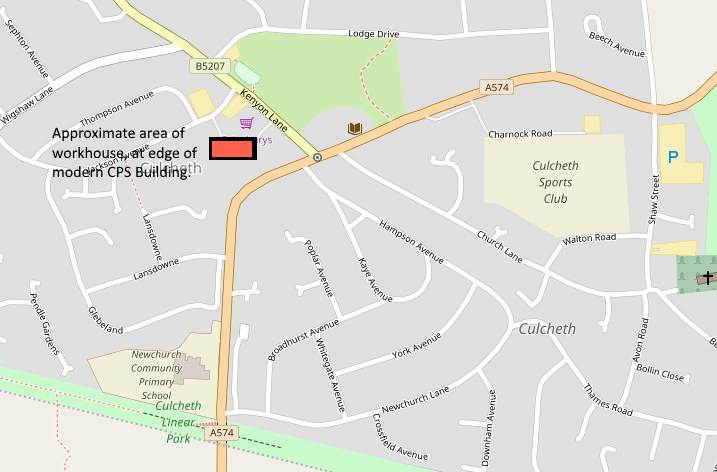Reports
- Details
- Category: Reports
2017-11-09 Bridge to Bridge
On Thursday November 9th, 2017 Barbara Worrall of the Latchford History Group a local non profit making group who meet at St Hildas Mission Hall, Slater street, Latchford gave a most profusely illustrated talk on Warrington "South of the Mersey" being "Bridge to Bridge". Warrington Bridge to Latchford Bridge.

The talk.

Population increased as new industry was established by the river. The majority of people resided near Warrington Bridge. This area then still in the parish of Grappenhall had its first chapel of Ease, St James built by the river in 1777. It was in this church that the Rev James GIazebrook opened the first Sunday School in the country. A photo of the church is above.



Latchford Station had to be elevated on the new embankment leaving the old station disused.
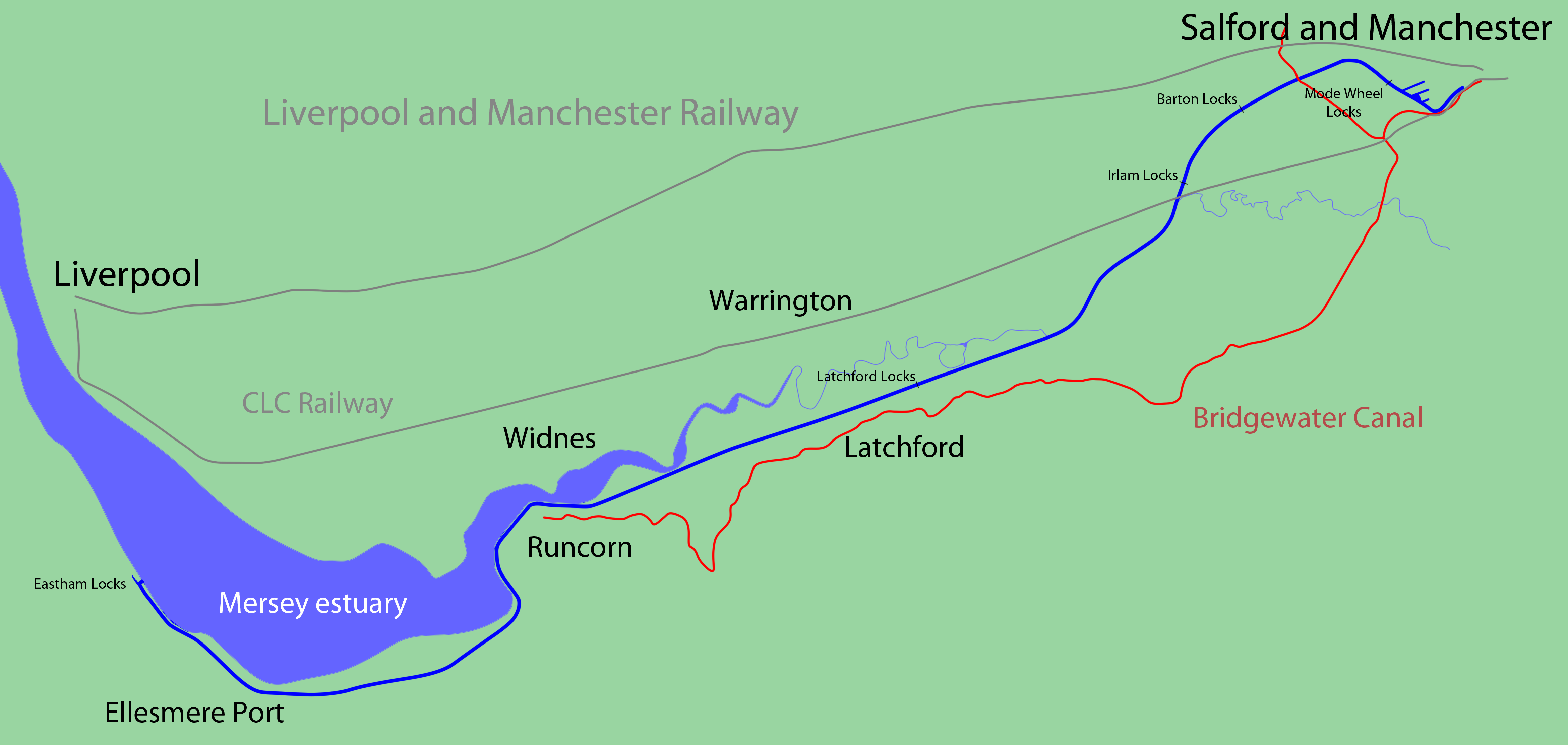

Twentieth century.

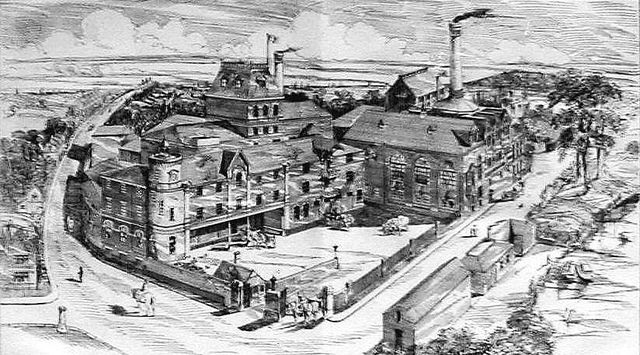



See bridge with another view including finished Cenotaph further below on page.

Gates to avoid vehicle or person entry when swung open to allow ships to pass.

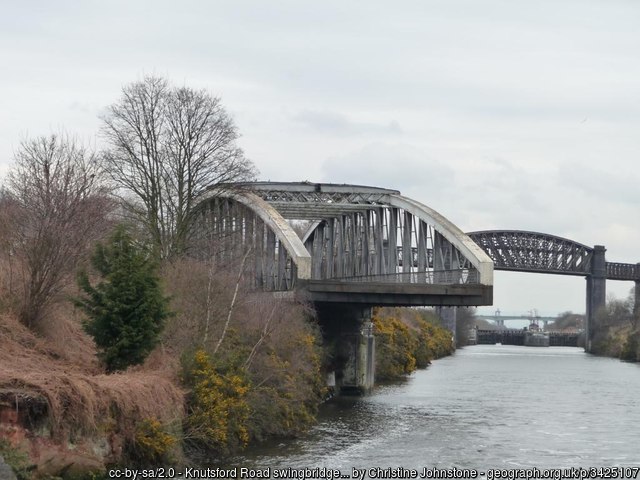
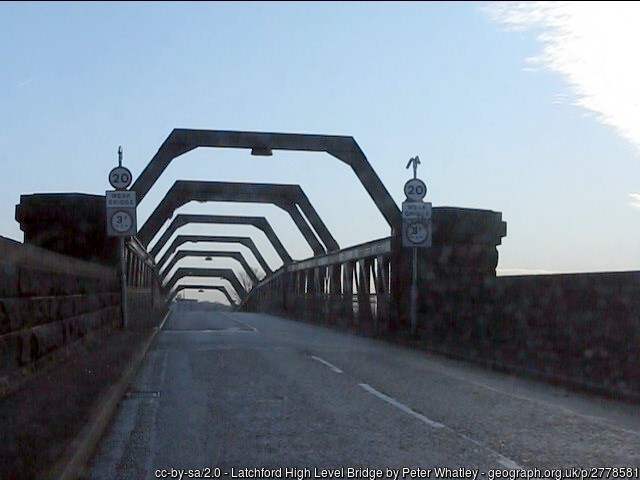

The Warington Bridge with finished Cenotaph.
The Northbound "Warrington Bridge" [The Sixth bridge].
.
Associated engineer: Webster & Fitzsimons: date 1909 - 1915
era: Modern category Bridge reference SJ606878; ICE reference number HEW254
photo: Paul Dunkerley
The bridge over the Mersey at Warrington, which is still tidal at this point, is the first British bridge to commence a construction type that incorporated reinforced concrete hinges in its design.
The first bridge on this site was in place in 1305. The current bridge is the sixth on that site..
Its reinforced concrete hinges, by Considère Constructions, are located at the mid spans of its eight 134ft reinforced concrete parabolic arch ribs.
They took a total thrust of some 240 tons during construction.
A new bridge was constructed 70 yards upstream of the 'Sixth Bridge' to take the southbound traffic of the A49 and Warrington Bridge now takes the northbound traffic.
This accounts for the complex crossing where central Warrington meets the Mersey.
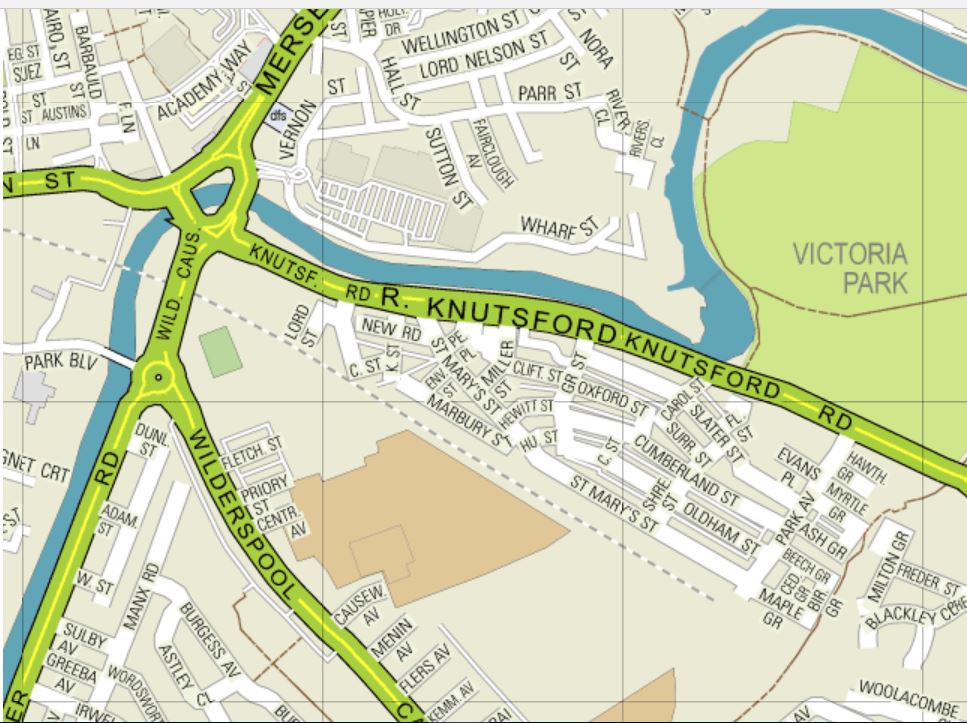
Outlying areas.
Disruption and division of being a 'boundary community'.
Text of this article is by Barbara. Worrall. November, 2017
Book available.From Latchford History Group.

The books can be obtained from the following members of the Latchford History Society:-
Joan Howard 01925 650340.
Brian Mercer 01925 838071.
Linda Pearson 01925 602803.
Barbara Worrall 01925 266282.
The group meets every Wednesday at 10 am to 12-0 noon at St Hilda’s Mission Hall, Slater Street, Latchford, Warrington.
Meeting display.
Thanks.
- Details
- Category: Reports
Lunt Meadows, an ancient village?
On Thursday the 12th of October 2017, the group welcomed Ron Cowell, MCIfA, who is on the staff of Museum of Liverpool, as Curator of Prehistoric Archaeology and is a specialist in the prehistoric archaeology, landscape archaeology and wetlands of North West England.
His excellent explanation working from memory to explain the photographs he showed enthralled our members.
An exciting evening, where the road network delays caused a slight delay so we had tea before the meeting started, and eventually with a working projector, we had to rely on Ron’s memory and exceptional knowledge. The magic lantern modern style photos were very well explained and left the audience thirsting for more.

Ron Cowell, and volunteers at site.
Source:
http://www.dayofarchaeology.com/wp-content/uploads/2015/07/6-Down-comes-the-Rain-695x521.jpg
More photographs of site at bottom of page, before the 'links' to other websites with information on this site.
The videos (Vimeo & YouTube links below, videos by others) are recommended for viewing.
Site.
Lunt Meadows is a site in Sefton. Lancashire where in 2012 Ron Cowell found evidence of structures and a way of life we little understood and much is added to our knowledge by the recent work of staff and volunteers excavating the area including a possible ritual marking by stones including an Iron Pyrites lump as central marker; as well as its use as a survival and shelter place.
Location Map. Lunt Meadows Nature Reserve, nr Crosby, Merseyside, L29 7WL.
Volunteers and visitors get an explaination of the site.
Photo from website:
http://www.dayofarchaeology.com/sieving-the-mesolithic/

Website blog by Halligan; “I am an artist/photographer with an interest in archaeology, history and psychogeography..”
A photograph of the site at evening with birds from website:
http://www.dayofarchaeology.com/luntmeadows/

Ron Cowell' site photo with birds.

Excavation map

Elaborately placed stones arround the central 'object' .
The Village
The ‘village’ had huts and perhaps a ritual site with a central ‘fool’s gold’ iron pyrites stone surrouded by placed smaller stones over a period of time in aritual arrangement. A considerable stone toolkit was found in various types of tools. The site dates to about 8000 years ago,[5.800BC per radio carbon dating] in the Mesolithic period, when groups of hunter-gatherers lived in the flood-plain of the River Alt leaving behind relatively well-preserved traces of a series of building floors dotted with pits in two defined, adjacent areas. Finds include many burnt hazel nuts, stone tools, burnt wood and a special arrangement of stones round a central iron pyrites large lump ion a 'table' or 'flooring' of flat stones.
Notes of a visit to site. (includes above site map. and much interesting detail.)
A very personal blog on a visit to the excavation site with the above map of excavaion is given on “Gerry’s” website. Gerry is a retired college teacher living in Liverpool, UK. Website published July 27, 2016.
https://gerryco23.wordpress.com/2016/07/27/conjuring-lost-lives-from-the-sands-of-lunt-meadows/
Finds
The finds are given on website:
http://www.liverpoolmuseums.org.uk/mol/archaeology/projects/lunt-meadows/finds.aspx
Extracts:
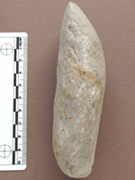


Above are: flint axe; arrowheads and piercing tools; a polished pebble; a flint in volunteer’s hand.
The burnt wood pictures are at the bottom of the web page.
Refer to above website for a fuller detail on the finds.
Ron Cowell’s article on Day of Archaeology.
http://www.dayofarchaeology.com/luntmeadows/
The Museum of Liverpool Project Website
Liverpool Museums site gives an overview , the settlement and the finds.
http://www.liverpoolmuseums.org.uk/mol/archaeology/projects/lunt-meadows/
http://www.liverpoolmuseums.org.uk/mol/archaeology/projects/lunt-meadows/settlement.aspx
http://www.liverpoolmuseums.org.uk/mol/archaeology/projects/lunt-meadows/finds.aspx
Videos.
An overall view is given in two “YouTube” videos of broadcasts in 2012.
Video Links:
The folowing video links to YouTube BBC items are interesting and show the excitement of the dig at its age confirmation.
Opening Day. [Silent video.]
https://vimeo.com/179164081
BBC Video
BBC North West Inside Out episode on Lunt Meadows, November 2012
on YouTube: (This author considers this video to be well worth watching for the excitement of the age announcement.)
Link:
Video of site interview and age announcement.
https://www.youtube.com/watch?v=kniVY4qV-K4
An overseas visitor's opinion.
Enjoying archaeology as a volunteer from overseas at this site. Refer to website:
Sieving the mesolithic blog by By Dr. Jessi Halligan / 08.05.2016
Assistant Professor of Anthropology, Florida State University
http://brewminate.com/sieving-the-mesolithic/
Development.
The site is part of a flood storage reservoir, and the excavations came about during its development and its subsequent use as a nature reserve.
Site work funding .
Archaeological excavations at Lunt Meadows were commissioned and funded by the Environment
Agency, supported by National Museums Liverpool ahead of the transformation of farmland in the Alt valley, Sefton into a wetland reserve and flood alleviation scheme.
The Official opening day of wetland reserve.
Saturday 23 July 2016 marked the official opening of the Lancashire Wildlife Trust’s
newest nature reserve, Lunt Meadows, near Sefton.
This included events surrounding the archaeological discoveries at Lunt Meadows under Ron Cowell in conjuction with the National Festival of Archaeology and Ron Cowell of the Museum of Liverpool was on hand giving some talks about the settlement that was here at Lunt in the Stone Age. Today the CLHG members and visitors had a very good view of the results of these achtivities with Rob Cowell’s explanations and the culmanation of many years of work by him in that area.
Website: Lancashire Wildlife Trust:
http://www.lancswt.org.uk/reserves/lunt-meadows
Nature Reserve.
The launch of the nature reserve and the completion of a range of works funded by the Heritage Lottery Fund and the Veolia Environmental Trust has seen bird watching screens and signage installed, gates and pathways added and fencing to allow grazing over the reserves wet meadows.
Lunt Meadows covers 67 hectares and has been transformed from fields of cereals and oil seed rape into a mix of wet grassland, reedbed, pools and open channels.
Flood Storage Reservoir.
The site was created by the Environment Agency as a flood storage reservoir and is designed to capture flood waters from the River Alt in times of high flow. It is managed by the Trust as a nature reserve and is already proving very popular with visitors due to its rich array of wildlife, which ranges from wetland and wading birds, to colourful dragonflies and butterflies. It was during this work that the Lunt Meadows Mesolithic site was uncovered.
Pictures.
(Extracted from the references websites and all copyrights acknowledged. Museum of Liverpool images under CC by SA)


The Peat deposit

Site photos with excavators working.


Visitors and volunteers listen to details of site.

Excavated burn wood.
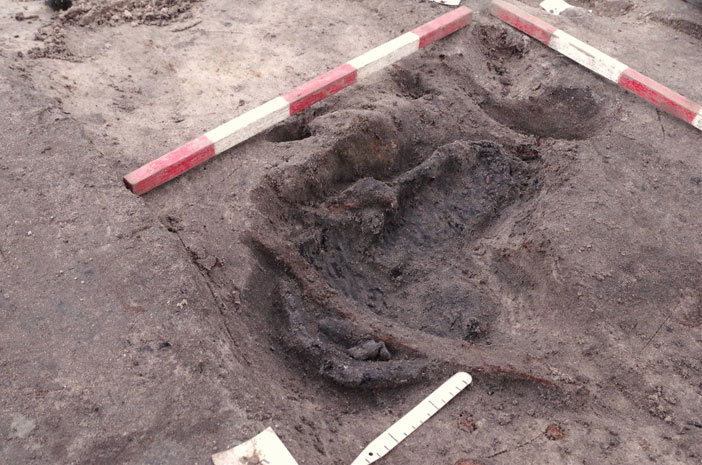
Burnt wood still in the ground, before excavation.
Replica Houises. (DIY style).
Replicated mesolithic houses based on the post holes constructed by folk from Phoenix Futures, Wirral, who constructed two Mesolithic-type structures for the Open Day. Pictures from Ron Cowell's article on Day of Archaeology.

Formby Civic Society.
Formby Civic Society has an article with many pictures from their day trip to site on their Flickr web page.
Link to Photos on Formby Civic Society Flickr page
https://www.flickr.com/photos/formbycivicsociety/albums/72157671145052126
Further study websites. Links:
Opening Day
https://vimeo.com/179164081
Wildlife
http://www.westlancswildlife.org.uk/
see links to may websites concerned witgh wetlands and Sefton
http://www.westlancswildlife.org.uk/useful-links/
Birding
http://knowsleybirding.blogspot.co.uk/2015/08/lunt-meadows.html
Gardian Report Monday 19th November 2012 by Maev Kennedy.
https://www.theguardian.com/science/2012/nov/19/stone-age-nomads-merseyside-dwellings
Flooding risk.
This includes a video of the Alt river busting its banks.
http://www.floodready.co.uk/pageinfo.asp?Sefton---Lunt-Meadows-Washland-c13.html
Lancashire Wildlife Trust
http://www.lancswt.org.uk/reserves/lunt-meadows
Dredging Today announcement. (Site gets into many non archaeological articles.)
http://www.dredgingtoday.com/2012/11/22/sefton-project-significant-archaeological-discovery-uk/
The Megalithic Portal report
http://www.megalithic.co.uk/article.php?sid=33792
LiverPool Museaum Blog post marked Lunt-Meadows-Washland-c13
https://blog.liverpoolmuseums.org.uk/tag/lunt/
Excavations Photos report
http://www.dayofarchaeology.com/8000-year-old-hazelnuts/
Photos on Formby Civic Society Flickr page
https://www.flickr.com/photos/formbycivicsociety/albums/72157671145052126
Sieving the mesolithic blog.
http://brewminate.com/sieving-the-mesolithic/
Blog of Liverpool visitor Gerry to site.
https://gerryco23.wordpress.com/2016/07/27/conjuring-lost-lives-from-the-sands-of-lunt-meadows/
BBC Video
BBC North West Inside Out episode on Lunt Meadows, November 2012 on YouTube
https://www.youtube.com/watch?time_continue=98&v=r9fAdsa3bPg
BBC North West Video
https://www.youtube.com/watch?v=kniVY4qV-K4
JMU Journalism TV Channel 27 Nov 2012
New theories from Lunt Meadows.
https://www.youtube.com/watch?v=jILR122AmZ4
UCD University Colledge Dublin
Recreating a mesolithic house
https://www.youtube.com/watch?v=WKYPLffs748&index=6&list=PLSa3rqHCqKI4PCc_uNkYF6Z9Zh8IFLmji
Education video of mesolithic life
https://www.youtube.com/watch?v=nramanQfZbU&index=7&list=PLSa3rqHCqKI4PCc_uNkYF6Z9Zh8IFLmji
Picture of speaker, visitor & member from:
http://www.dayofarchaeology.com/wp-content/uploads/2015/07/6-Down-comes-the-Rain-695x521.jpg
Thanks.
The members of Culcheth Local History Group and their visitors wish to thank Ron Cowell for his talk, and also to all his staff and volunteers over the years whose hard work made the discovery and the talk possible.
- Details
- Category: Reports
2017-09-14 Warrington Rail Transporter Bridge
2017-09-14 Rail Transporter Bridge
On the 14th September Members were delighted with the enthusiastic and informative talk given by Margaret Ingham. The chair of a local group called 'Friends of Warrington Transporter Bridge' (FoWTB) which was formed in April 2015 to act as the independent voice of the bridge and act for its preservation.
It is the only rail transporter bridge built, and is one of 12 remaining bridges in the world, of which there three are in the UK.
Only 22 bridges were built with the Warrington one being the last one.
Reference List at:
https://structurae.net/structures/bridges-and-viaducts/transporter-bridges/list
Existing UK bridges: Warrington, Tees (Middlesbrough), and Newport.

Contact details:
'Friends of Warrington Transporter Bridge' (FoWTB)
Website:
http://www.warringtontransporterbridge.co.uk
Postal address:
FOWTB
4 Chalfont Close,
Appleton,
Warrington,
WA4 5JT
email:
The talk inspired a few members to consider a walk to the bridge, (good footwear advsable; avoid vegitation on side of paths) while some recalled playing and walking their dogs near it.
The meeting on FOWTB Facebook site.
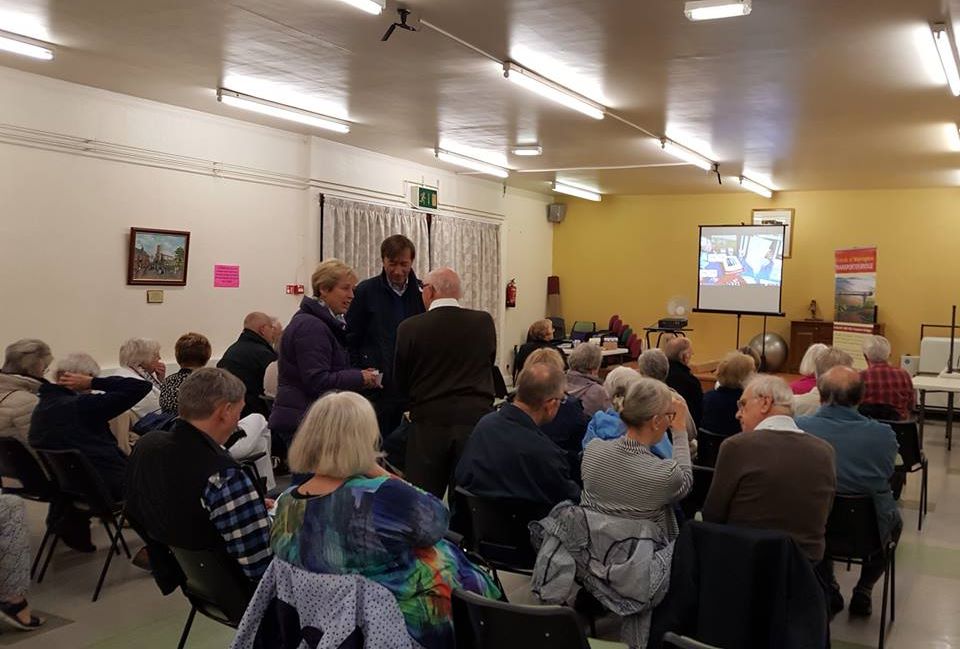
For details of how to walk to the bridge and visiting it, please refer to FOWTB website.
http://www.warringtontransporterbridge.co.uk.

Bridge Name.
The bridge goes under a number of different names occasioned by its history.
"Warrington Rail Transporter Bridge"
"Warrington Transporter Bridge"
"The Transporter Bridge" to locals on Warrington.
"Crosfield's Transporter Bridge"

A private transporter bridge.
This was the only transporter bridge built by a private company.
The others were for public use and publicly financed.
Crosfield's soap works started in 1814 as a chemical works for the production of soap and were the owners as the bridge was for their private use within their chemical site and with a side line in cement to use up a hazardous material they were asked to stop 'dumping' in the River Mersey. The bridge transported on rail wagons the raw hazardous stuff to the cement works on the other site where it was used in cement manufacture.
Founding.
Joseph Crosfield was a Quaker businessman who established the soap works on the banks of the Mersey in 1814.
Soap consumption doubled per head of population in the first half of the 19th century.
Add to this the increase in population who came to use easily available soap from Crosfields and other manufacturers with a consequent increase in popular health, and the population itself also grew fast.
Crosfield, and his offspring as owners/operators of the plant learn from German advances in chemistry.
This altered the 'chemical works' and the Warrington landscape.
The site still operates after many changes in ownership, but no longer makes "soap".
The Joseph Crosfield & Sons chemical works at Bank Quay was sold to Runner Mond in 1911 (family quarrels involved in this as one side favoured Unilever) and then passed to Unilever, then to ICI, then Ineos Capital in 2001, where after the 'Crosfield' brand was dropped for 'Ineos Silicas' and since the merging of Ineos Silicas and PQ Corporation in 2008 it became PQ Silicas UK Ltd. part of PQ Corporation.
Link to current ownership:
http://businessperson/news/home/20080702005824/en/PQ-Corporation-INEOS-Silicas-Merger-Complete
Arial view map

Why the transporter bridge?
To keep an open passage for ships on the Mersey when the bridge was not in use. The height of side supports cleared the masts of the ships.

Gate View.
Use.
We quote from a website devoted to cement kilns, which gives details of the 'use' of the bridge.
link
http://www.cementkilns.co.uk/cement_kiln_crosfield.html
(Source material for their site is: Jackson, pp 221, 277: A. E. Musson, Enterprise in Soap and Chemicals: Joseph Crosfield and Sons Ltd 1815-1965, Manchester University Press, 1965)
Quote:
Raw materials:
Soap works waste
Mersey alluvium from Ardley Meadows, 360300,387000 – Warrington, Lancashire: brought down the river by barge.
Ownership:
1907-1911 J. Crosfield and Son Ltd
1911-1919 Brunner, Mond and Co. Ltd
1919-1929 Lever Brothers Ltd.
Crosfield’s main business was soap, but they were also a significant producer of sodium silicate. The main plant was the Bank Quay works on the Lancashire side of the Mersey in Warrington. The plant produced waste calcium carbonate from conversion of sodium carbonate to sodium hydroxide. Until 1899, the carbonate sludge was dumped in the Mersey at a rate of about 150 tonnes per week. Crosfield’s were finally prosecuted following pressure from the Ship Canal company, the Mersey Conservancy Board and the Borough of Warrington. In 1899, filter presses were installed and the resulting concentrate was re-used, some in whiting and some in bleaching powder, but mostly as agricultural lime. Sales were around 20,000 tons at £0.15 per ton in 1904-6.
Optimism about the future progressive increase in tonnage led them to embark on the cement plant project in 1905. The plant was built on the opposite (south) bank of the river, and included in the project was the construction of a transporter bridge (the first of two). The carbonate (now once again handled as sludge) was pumped to the plant over the bridge, and was washed with local clay. The plant was not up and running until the end of 1907, and Davis’ 1907 capacity of 300 t/week must have been a projection. The plant was operated, irrespective of cement trade conditions, to absorb the available carbonate waste, and only made a profit in one or two years of its life.
In John Hudson Earley's diary (R 27/3/1908), he was told by the Polysius rep that Crosfield’s “have not enough waste products to keep one kiln going, but they have told (him) that they are trying to buy other waste products from Lever Bros. & other soap people & if they succeed they will put a second kiln down”.
Its turnover was never more than 2% of the overall plant’s turnover. It is, however, noteworthy that the amount of cement produced was always less than half the stoichiometric amount expected from the plant’s sodium hydroxide production (2.2 tonnes cement per tonne of NaOH), and it is likely that persistent operational and product quality problems were the main factors in its failure.
In 1929, the sodium hydroxide plant was changed to the Mount process, in which calcium carbonate precipitate is converted back to lime in a rotary kiln (not the same one) and recycled. The cement plant closed when this became operational.
The plant despatched product by rail: trucks loaded on the peninsula were carried by the second transporter bridge across the Mersey to the company’s railway sidings. The site of the cement plant was subsequently redeveloped with other plant. Attempts are being made to preserve the second bridge, which is a scheduled monument, see website.
Rawmills
The rawmill arrangement is unknown, but evidently there were initially washmills in which the clay was combined with carbonate slurry.
Two rotary kilns were installed.
Unquote
Old Site Map.

Notes to Cement Kiln map. (Map Copyright Dylan Moore 2012)The first transporter bridge, at the north of the peninsula, was erected for light goods and passenger transport to the cement plant, which was the first development south of the river. It also carried the pipeline for delivering calcium carbonate sludge from the alkali plant at the northern edge.
The second transporter bridge (the subject or the talk) was erected to despatch finished product from the cement plant and the subsequent developments. Clay for mixing with the alkali sludge was landed at wharfs on either side of the second bridge. The rest of the south bank development consisted mainly of oil extraction plant on the west side, and the oil hydrogenation plant on the east side (the "VB plant" = Vegetable Butter). This was the UK's first plant making margarine from vegetable oils by Sabatier-Senderens hydrogenation.
Preservation.
The good work of 'Friends of Warrington Transporter Bridge' (FoWTB) aims to keep the bridge in its present state and which will take a great deal of cash, so they welcome all donations to enable then to bring about public knowledge of the bridge and act for its preservation.
Signs to the bridge have been erected in the last few years due to their actions and there is some interest in Warrington of its position in the town as a world status tourist attraction (certainly to engineers!).
Listed on Buildings at Risk Register by English Heritage as Grade II* ('Grade Two Star')
It is also a scheduled monument.
The bridge is preserved under a 50 year lease in possession of Warrington Borough Council.
The lease expires in 2027.
Currently the gondola remains intact.
Links:
Newport Bridge.
http://www.newport.gov.uk/heritage/Transporter-Bridge/Transporter-Bridge.aspx
Tees Bridge.
http://www.visitmiddlesbrough.com/where-to-go/attractions/tees-transporter-bridge-and-visitor-centre
UK Bridges.
http://simplonpc.co.uk/UKTranspoters.html
Here there are a lot of good photographs.
- Details
- Category: Reports
20170810 Police Museum Warrington
On August 10th 2017 some members and guests visited the old but still working police station in Warrington to see the "Museum of Policing in Cheshire", the museum is an independent charity run by volunteers in co-operation with the Cheshire Constabulary.
The visit was enjoyable and members saw the old cells and a small 'spy hole' in a door through which one person escaped.
The Museum has the formal name of "Museum of Policing in Cheshire" and is located within the working police station at:
Warrington Police Station,
Arpley Street,
Warrington,
WA1 1LQ
Museum website link:
http://www.museumofpolicingincheshire.org.uk
Location link:
http://www.museumofpolicingincheshire.org.uk/Museum/location.html
Members and others are encouraged to visit the museum to learn of the past and see the problems of policing.
Visits are by appointment only.
The museum is located in the County Police Office, Arpley Street, Warrington, Cheshire, WA1 1LQ, near Warrington Bank Quay railway station.

Working Headquarters.
This is a working Police Station and the Headquarters of the Warrington Division of the Cheshire Constabulary. For security reasons, visits are by appointment only. Visits can be arranged for groups such as schools and others; and (are as we were) are given a tour by the museum volunteer staff. Visits should be arranged by reading the instruction on the museum website and by filling in their contact form on website link
Contacting by post:
The Museum of Policing in Cheshire
County Police Office
Arpley Street
Warrington
WA1 1LQ
For all enquiries about visiting the museum please contact the busines manager Peter Quinn via their website contact page:
http://www.museumofpolicingincheshire.org.uk/Museum/Contacts/Visit2.aspx
(The writer is pleased to note that the museum contact form includes the option to send a copy of your request email to them to your own email address. This courtesy is often omitted from many website contact forms. EM.)
"Atractions".

The museums "Attractions" are shown on their website.
This is a good well arranged website and has a detailed and easily searched record of exhibits and police records shown on their collections page.
Members and others are encouraged to visit the website for an understanding of policing in our area.
Link to collections page.
http://www.museumofpolicingincheshire.org.uk/Collections/collections.html
Plan of Museum.

History of Museum.
A brief note about the museum from their published data.
Police forces, by their very nature, have always been averse to throwing things away. Oddments have collected over the years into small displays, the forgotten corners of storerooms and the private collections of officers. During the 1960s and 70s, when the Cheshire Constabulary became the main overall force, many of these items were collected into a display at the Force Training Centre at Crewe. This display however was not open to the public. Documents were deposited at the Cheshire County Archives at Chester.
On retirement PC Peter Wroe began to organise items at Warrington into a museum. He greatly added to the exhibits by persuading former officers and their relatives to donate their private collections. Together with former PC Jim Talbot a large amount of documentary information was also collected and organised. In 2004 the Crewe Centre closed and the exhibits came to Warrington. The size of the collection was then such that a more formal structure had to be established to manage it.
In 2006 The Museum of Policing in Cheshire was formed as a private trust with a board of management under the trustees. Peter Wroe was appointed as Curator. The museum's objective is to advance public knowledge of the evolution, development and role of policing in the County of Cheshire from its inception to the present day. It does this by collecting, preserving and researching anything connected with policing in the County and making the results available to the public as displays in the museum, by publishing and on this web site. In 2007 the museum was opened to educational groups.
The naming of the museum indicates that its remit is all of the forces which were, at any time, part of the County of Cheshire. Many of the smaller forces have disappeared on amalgamation or with changes to the County boundaries. The museum is independent of the Cheshire Constabulary although the force does supply generous logistical support.
The museum is not just for the police. Policing is an integral part of our society and of the history of the County of Cheshire. To emphasise this connection the museum seeks links with many County institutions. The Grosvenor family is one of England's oldest noble houses, their main seat being at Eaton near Chester. They have always had friendly links with the Constabulary and the museum is delighted that the current head of the family, The Duke of Westminster, has agreed to become its patron.
The museum is a registered charity run on a voluntary basis with expenses being met by the donations of its supporters. From 2007 it has been open to groups by appointment. In 2010 the museum was refurbished with generous grants from Wren and Biffa and reopened in January 2011. It also became an accredited museum under the Museum, Libraries and Archives scheme by meeting national standards.

Thanks.
Our members than the volunteers who helped duringthe visit and we also than the museum's webmaster for a well constructed website.
- Details
- Category: Reports
20170511 "Lord Haw Haw" by Brian Joyce
IMPORTANT. The speaker Brian Joyce is no relation to the William Joyce who was the subject of the talk.
Thanks.
At very short notice due to unavailability of the planned speaker, Mr Brian Joyce stepped in and gave a talk.
The members thank Mr Brian Joyce for his delivering one of his talks to us on May 11th , 2017.
An informative and detailed talk on the life of William Joyce, who was given the nick name of "Lord Haw Haw", who acted as an English Language 'news reader' and propagandist for the "Nazi"regime of Germany. Many points about his early life, political career, actual birth nationality and the eventual trip to Germany on a British passport were given. The talk was enjoyed by most of our group although some who had heard him broadcast found they learned things they did not know.
Rather than try to summarize a very complicated life story and events, we list references below which detail much of what was in Brian Joyce's talk.
Detail.
The detail in the talk that was much discussed by folk at the meeting and effected then deeply was the fact that speaker told us of how William Joyce's activities effected his daughters by his first wife, they had never know him after their first few years, but one a devout Roman Catholic who the speaker had met kept doing voluntary service to a local Jewish Synagogue during her life.
Illustrations: (By coutesy of Mr Brian Joyce)
Photograph of Wiliam Joyce.
The accent.
The nasal twang was due to a broken bone after a youthful conflict. However William Joyce's accent was not the origin of the "Haw Haw" (that was due to another person with a 'posh' accent) but it transferred to William Joyce and stuck.
The facial scar was due to a fight at a political meeting where he was cut by a sharp instrument (a razor, perhaps).

The UK passport declaration.
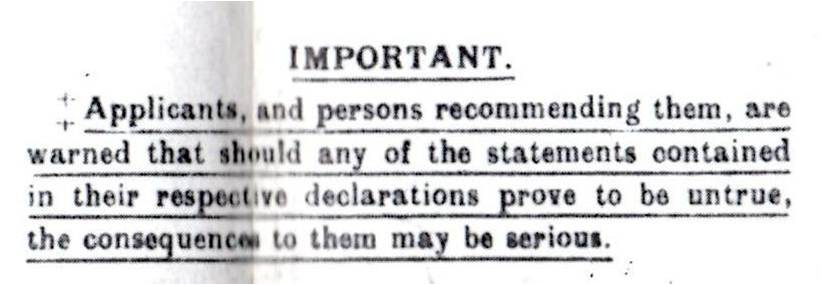
Broadcasting while in Germany during the validity of the passport was the key element in the verdict of guilty for treason on one of the three offences of treason with which he was charged. The other two charges of treason were dismissed as they concerned dates outside the passport validity.
The Capture of William Joyce.
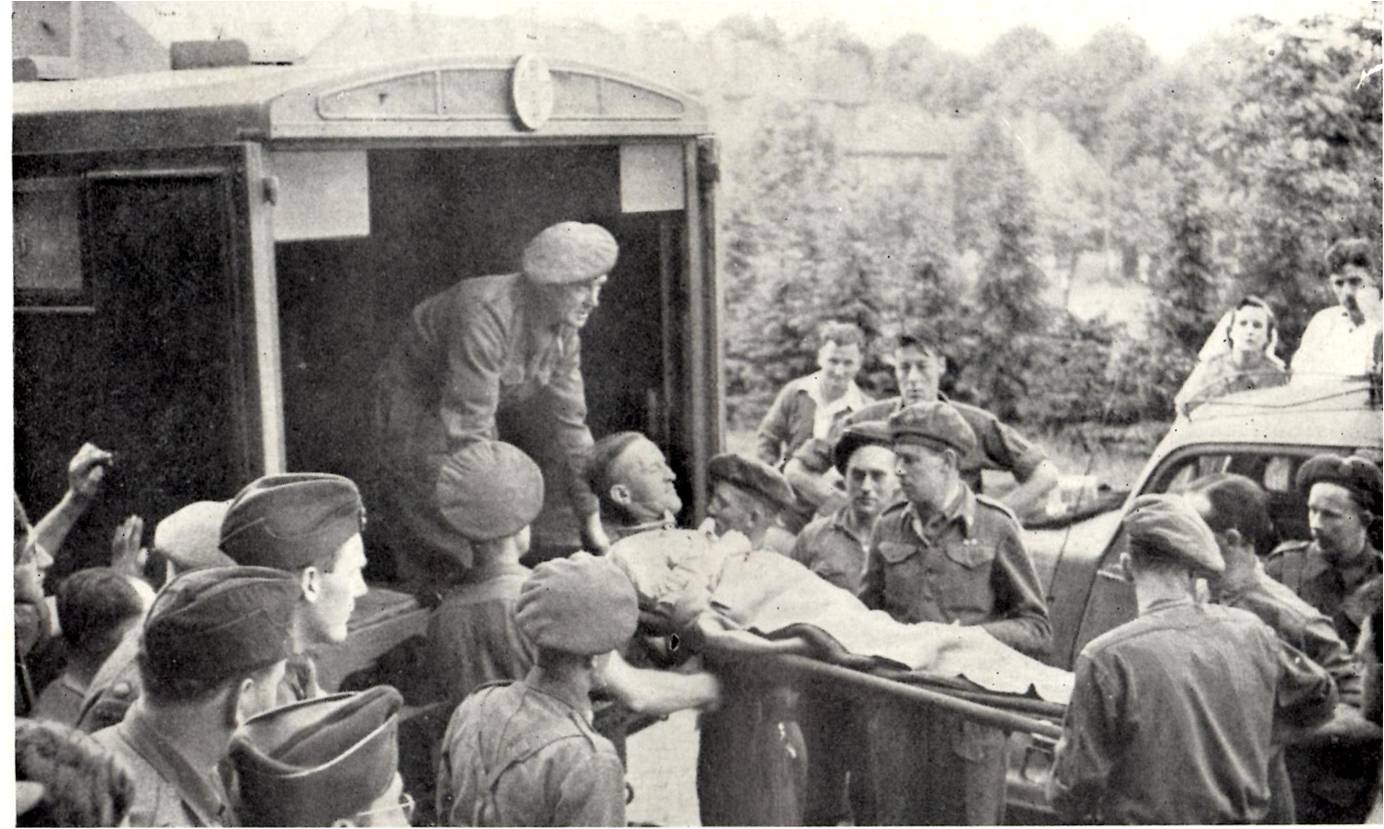
The Caricature based on Norman Baillie-Stewart's voice.
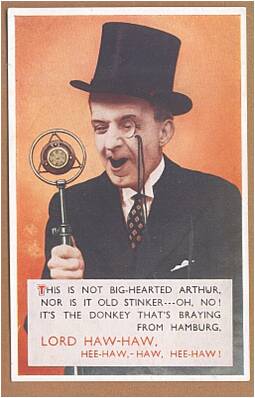
Quote:
The exact source of his sobriquet, 'Lord Haw-Haw,' is not entirely clear, but most attribute it to Daily Express radio critic Jonah Barrington, who described a propaganda broadcaster as speaking "English of the haw-haw, damn-it-get-out-of-my-way variety, and his strong suit is gentlemanly indignation."
Although the name "Lord Haw Haw" was attributed to Joyce, the broadcast heard by Barrington was actually made by Norman Baillie-Stewart, a Sandhurst-educated officer who's voice sounded far more pompous than the American-Irish nasal twang of Joyce.
References:
The two short summaries of William Joyce's life are given in:
Biographical_Article
http://www.biography.com/people/william-joyce-17172178
And an unfinished as it is incomplete of internal references in Wikipedia.
https://en.wikipedia.org/wiki/William_Joyce
Trial article.
https://theoldbailey.wordpress.com/2008/06/06/william-joyce-lord-haw-haw/
The Guardian report on his daughter.
https://www.theguardian.com/politics/2005/dec/05/past.secondworldwar
Thanks.
Many books and articles exist on the persons and politics of that time and the summary by Brian Joyce of his research into William Joyce was well done.
- Details
- Category: Reports
Finds identification and handling – Warrington Museum
Date(s): Saturday 28 July 2012 - Wednesday 30 November -1
Timings: 11:00:00 - 15:00:00
Address: Warrington Museum & Art Gallery Museum Street, Cultural Quarter, Warrington, WA1 1JB

Notice details:
website for PAS : www.finds.org.uk
PAS finds days at Warrington Museum
Time of events 11.00-14.30 [11am until 2.30 pm]
Saturday 15th July 2017
Saturday 21st October 2017
Saturday 20th January 2018
Saturday 21st April 2018
Saturday 21st July 2018
Saturday 20th October 2018
Please bring along any objects which you wish to have identified and recorded on www.finds.org.uk/database including metal finds, flint and pottery which are more than 300 years old. Please bring along the grid reference/find spot of the object also in order that a record can be made.
Guidance on how to get grid references using both maps and computer mapping software / GPS etc. can be provided
Tel: 0151 478 4259
Mob: 07837356386 – (this artefact will not take images, calls or texts only!)
- Details
- Category: Reports
20170413 Chat Moss Project.
On Thursday 13th April 2017, we had a talk with extensive slides and some videos of the “Chat Moss Project” by Lydia McCool, of The Lancashire Wildlife Trust on the origins, importance (economic and for ‘life’ purposes) and use of raised bogs with special reference to the ones nearby Culcheth. There was a lively interest from our members and visitors, albeit some had found the tracks to the moss lands ‘rough’ on cars and with problems in parking, however these are due to be resolved with new in-road from Holcroft Lane and parking areas in next couple of years, so we can all get a better appreciation of the residual bogs.
We learned of the importance of bogs in carbon retention, and were invited to visit the project and its bogs individually or in parties, where they can cater for school and accompanied youngster visits. New parking underway to make access easier.
Wildlife article on what to see.
Wildlife on the Mancunian mosslands. Many links to map and wildlife photos and links to supporting sites and article on the local mosslands.
(https://mancunianbirder.wordpress.com/2015/06/05/naturalists-guide-to-the-salford-wigan-mosses)
(Naturalists Guide To The Salford & Wigan Mosses)Chat Moss Project.
This summary is taken from the trust’s website. It was the core of the talk. "We" in report indicates the Chat moss Project Team.
The Chat Moss Project aims to restore Lowland Raised Bogs in the Chat Moss area and engage local communities with this fascinating habitat.
The Chat Moss project is an exciting five year scheme funded by the Heritage Lottery Fund.
It involves working on the restoration of the Lancashire Wildlife Trust’s reserves in the Chat Moss area, surveying the flora and fauna of the sites and engaging local people and volunteers to raise the profile of the sites and to assist the Trust with the management of the reserves.
Check out the latest blog from our Mosslands team here.
Link:
Lancashire Wildlife Trust Chat Moss project
(https://www.lancswt.org.uk/chat-moss-project)
They are starting a 'Friends of Little Woolden Moss' group and are looking for local people to get involved and help shape the future of this recovering mossland.
Click here for more information.
The History of Chat Moss.
Chat Moss was originally a huge expanse of Lowland Raised Bog, dating back 10,000 years. An enormous tract of mire, fen and bog, it was pretty much unexploited by people until the 19th Century.
One of our most impressive feats of human engineering, the construction of the Liverpool to Manchester railway across the middle of this ‘uncrossable’ wetland, was the beginning of the end for Chat Moss.
Peat was extracted and sent along the railway to Manchester to be used for horse bedding, the same carts would then bring back the night soil of the sprawling metropolis to be spread on the moss, creating a fertile land that would grow almost anything... with enough drainage. The moss was tamed; agriculture and peat extraction had made it a very human landscape.
The current situation
Today, only 3% of the lowland raised bogs of the Trust area remain in some sort of salvageable condition.
Many are in a poor state and almost half of these sites are still being worked for peat extraction.
The Lancashire Wildlife Trust is working desperately to protect these hugely valuable fragments and restore them to living, breathing mosslands once more.
We own three sites in the Chat Moss area; Astley Moss, Cadishead Moss and the recently purchased Little Woolden Moss.
The intention of the Chat Moss project is to develop a matrix of reserves and wildlife-rich mosslands which will connect with other bogs and wetlands in the Greater Manchester area, creating a Living Landscape; for people as well as the many wetland species that are in rapid decline.
What work are the trust doing?
All of our reserves have been peat extracted at some point in the past. Astley Moss was abandoned and became fairly wooded before coming into Trust management 30 years ago. It is now developing into a wonderful mossland reserve. With a little more work on getting water levels just right and a wider variety of bog plants, it will be well on its way to full restoration.
Cadishead Moss was acquired in 2009. With extraction on part of the site continuing until this time, there was no wood to remove, and the network of ditches and bunds left by the extractors have been utilised to give us a very diverse mix of deep and shallow pools separated by low peat mounds. We have already seen a huge increase in bird species such as Snipe and Reed Bunting since we took over the site, with cotton grasses flourishing and mosses starting to spread through the damper areas.
Little Woolden Moss was worked for peat until it was bought by the Trust in August 2012. It is a huge 107 hectare site and work is currently taking place to block the drainage ditches and level the bare peat surface – on a grand scale.
By raising the water table we will create a vast area of rewetted peat; perfect for recolonisation by mossland flora and fauna alike. Importantly, Little Woolden Moss is adjacent to our Cadishead reserve, so it will create an even larger for wildlife to flourish.
We will also be improving the access to these sites and we run a range of programmes to get people out onto the mosses and appreciating their unique wildlife, from volunteer work days to presentations and guided walks, surveying for wildlife to activities for kids.
Slides & Photographs. References.
Wikipedia article with note on the railway crossing of the moss.
(https://en.wikipedia.org/wiki/Chat_Moss)
Link to Ordinance Survey (c) map of Chat Moss.
(https://en.wikipedia.org/wiki/Chat_Moss#/media/File:Chat_moss_map_1937.jpg)

View of railway and mosslands in public domain.
Henry Pyall - T.T. Bury (revised edition 1833), Coloured Views on the Liverpool and Manchester Railway. London: Ackermann & Co; plate 5. This scan/photograph from the Stapleton Collection, via the Bridgeman Art Library (STC 267570) and Artfinder.com (description page, image)
The crossing of Chat Moss by the Liverpool and Manchester Railway. The creation of a stable trackbed across this treacherous area of deep peat bog was one of the most difficult challenges faced by the constructors of the line.
By Henry Pyall - T.T. Bury (revised edition 1833), Coloured Views on the Liverpool and Manchester Railway. London: Ackermann & Co; plate 5.This scan/photograph from the Stapleton Collection, via the Bridgeman Art Library (STC 267570) and Artfinder.com (description page, image), Public Domain, https://commons.wikimedia.org/w/index.php?curid=19417024

A traveller's sketch of the train at Chat Moss, November 1857
Artist: Frances Elizabeth Wynne.This image is available from the National Library of Wales You can view this image in its original context on the NLW Catalogue
Wildlife.
Lancashire Life article on the wildlife at Chat Moss.
Formation, history and notes on spagnum moss bogs. A good general introduction.
Spagnum moss bogs notes and wildlife
(http://www.newtonsapple.org.uk/spores-sphagnum-moss-and-wetlands/)
Carbon exchange. Bogs are very good at carbon capture, beter than woodlands.
(http://mucholderthen.tumblr.com/post/64689168742/1-the-mire-carbon-exchange-is-dominated-by)
Irlam Moss.

View of Irlam Moss (CCby SA) Ditches at edge.
Extent and area of Chat Moss
Chat Moss is a large area of peat bog that makes up 30 per cent of the City of Salford, in Greater Manchester, England. (per Wikipedia)
History. Map of area.
GB Historical GIS / University of Portsmouth, History of Chat Moss, in Salford and Lancashire | Map and description, A Vision of Britain through Time.
URL: http://www.visionofbritain.org.uk/place/25202
- Details
- Category: Reports
2017-03-09 Culcheth Workhouse and Pauper Apprentices
20170309 Culcheth Workhouse and the pauper apprentices.
This was a well researched and detailed talk given by our Chair Zoe Chaddock, which described the origins of Culcheth workhouse as well as aspects of the inmates' lives, using a variety of maps, original documents and a 3D (three dimensions) animation of the workhouse building. The latter gave an insight into the probable layout and use of the building and the site in general. These showed the extension and development of the original building and its later weaving shed, part of the profits of which went to the workhouse governor, an incentive for him to keep inmates working.
Photo of Culcheth Workhouse:

This shows the part leading straight to what is now the bend in the warrington road. The House was about eighty yards back from the road.
We learnt how and when the workhouse was established, heard about the rules which governed the everyday lives of the inmates, their diet and how their time was employed.
Albeit some must not have been properly fed as a parliamentary report now at Kew, shows a certain inmate died ‘allegedly from want’ in 1840. Refer “Jessie Redfern, weaver, Culcheth Workhouse, in reference document at the bottom of page.
Pauper Apprentices
The second part of the talk focussed on the pauper apprentices, some of whom had been inmates. We were told the ages at which the children were apprenticed, into what trade and where they were sent and learnt of the conditions under which some of the children would have laboured.
As the ability to get help from a parish depended on “right of settlement” or “declared settlement” in the parish, which was obtained at birth or by seven (7) years apprenticeship in the parish, this illuminated the reason for long 7 year apprenticeships. As after such an apprenticeship the apprentice had ‘settlement’ in that parish, and in case of poverty could seek relief in that parish.
This ‘declared settlement parish’ avoided folk moving from poor parishes to richer parishes (to be a burden on their taxation sources) to seek help and was regulated by the 1662 Settlement Laws which were passed to avoid mobility from poor to richer areas. Unfortunately, the laws greatly discouraged the unemployed from leaving the parish of their birth in order to find work elsewhere.
[Analogous to the present Russian system of internal passports, Паспорт гражданина Российской Федерации**, which define in which areas persons can live and work. **These are currently being replaced with “Identity Cards” with the same restrictions.]
We were also treated to stories of three individuals who had lived in the workhouse or been child apprentices.
Other Photos of the workhouse are in our display presentation article report. Links below:
http://www.clhg.org.uk/index.php/reports-future-events/culcheth-workhouse-display
http://www.clhg.org.uk/index.php/reports-future-events/rules-of-culcheth-workhouse
Location of workhouse on old and present maps.

Ex informative website www.workhouses.org.uk (see link below)
Current Open Street Map of area with insert location marked.)
General Information.
General information on the workhouse sytem are located on internet in articles linked below:
BBC Podcast
http://www.historyextra.com/workhouse
Website links
A well recommended read is the site by Peter Higgenbotham
A detailed site about the workhouse system, its history, laws and use in varous countries.
- Details
- Category: Reports
Weavers' Cottages
On February 9th 2017, our group had as a speaker Mr David George who gave a fascinating talk on the changing nature and varying styles of weavers’ cottages throughout the 18th and 19th century.
He talked about the early weavers' cottages, often deep in the countryside, where the weavers also kept smallholdings and were part of what was known as the “dual economy”.
[Perhaps similar to today 2017 where folk have two or three 'jobs', some in the 'gig economy' , which is quite different to the stable one job economy of 1900 ~ 1995.]


You Can Visit a Weavers' Cottage at Rossendale
Link
RossendaleCivic_Trust_Weavers' Cottages
http://rossendalecivictrust.org.uk/About%20The%20Weavers'%20Cottage.html

Weavers Cottages, Wardle, Manchester,
(c) Dr Neil Clifton Creative Commons under the Attribution-ShareAlike 2.0 license.
Putting-Out System (also 'domestic system')
We were told how the weavers were provided with raw materials by clothiers who also collected the finished goods from them to sell on.
[A fashion still today, where 'seed' is provided to farmers and crop is pre-sold to the seed provider.]
The Clothier’s home often also acted as a warehouse and weaving rooms and with its long bays of windows became the model for the later weavers’ cottages we are all familiar with.

Talk illustrations.
We were shown slides of various differing styles of weavers’ cottages from across the North West and learnt that the cottages were often owned by the same people who owned the large textile mills.
The cottage weavers could be used to fill smaller or more delicate orders taken by the mill owners.
Co-operative Building Society Clubs.
We were also told about “club houses”, where friendly societies of weavers themselves grouped together to raise funds to build a row of cottages.
Often lots were drawn to decide who got the next house built.
Tied houses.
Finally we heard a little about some of the cottages built for mill working weavers and not intended to act as a place of work as well as a home.
Thanks.
The group observed that the speaker was obviously deeply knowledgeable on the subject and the slides used throughout were extremely good illustrations of the building types being discussed for whichthe group warmly thanked the speaker.
References and illustrations.
These are from different sources to the talk. Howevere they will give some illustration and links to articles, and places, and the hand weaving community in UK 'Harris Tweed'


Modern Hand weaving (leg powered)
Refer link: Harris tweed
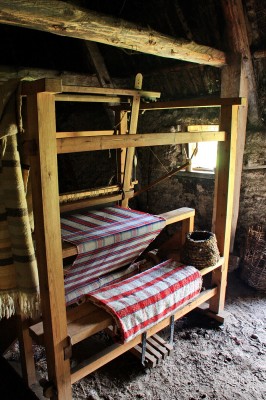
Video link
[https://www.youtube.com/watch?v=T6HLIBMS8Tk]
- Details
- Category: Reports
2017-01-12 Pretoria Pit Disaster..
[Report under construction]
On the 12th January 2017, our members had a splendid and enthusiastic talk by Mr Alan Davies about the Pretoria Coal Pit Disaster in Westhoughton in 2010. The personal experience of Mr Davies as an author, miner and archivist came though to give a most vivid recreating in the minds of those listening of the daily life and hardships of the working miners (both male and female) and the extreme effect of the disaster on the folk in the mine at the time of the explosion.
Summary.
At the outcome of the enquiry it was determined that a rock fall caused some events; the covering and death of a miner under the rock fall, the breaking or exposure of the flame in the miner’s lamp which ignited gas (perhaps from the rock fall) which then ignited coal dust in a chain reaction to give an explosive flow of fire and gas through the mine workings.
They went to work, they did not come home.

Death toll.
(Report with thanks to the website to which all readers are referred) See link:
http://www.lan-opc.org.uk/Westhoughton/Pretoria/
The outcome was an official death toll total of 344 deaths, comprising 328 colliery employees and 16 contractors and their staff, which was set on 30 Dec 1910 (BEN [Bolton Evening News] 30 Dec 1910) some 6 weeks before the last body to be found was recovered. The Lancashire & Cheshire Miners Federation compiled a register of victims for relief fund use, and the BEN published this ‘complete’ list on 30 Dec 1910. Taking into account errors and duplication, this ‘complete’ list missed four names – Robert Curwen, John Prescott, Henry Price and Robert Whittaker. Despite strenuous efforts by exploration teams, only 343 bodies were recovered and 343 deaths registered. As late as 6 Mar 1911 the BEN reported that “Work is still being pushed forward for the recovery of the remaining body in the Pretoria pit, so far no trace of it has been found.” – no trace ever was found. 342 men and boys at work in the No.3 Pit districts at the time of the explosion were killed. One man (Richard Clayton) died in the Arley Mine at No.4 Pit, and one member of a rescue team (William Turton) died on the first day while attempting to put out a fire in the South Plodder District of No.3 Pit. Only one of the dead from the Yard Mine (Fountain Byers) lived long enough to reach Bolton Infirmary, where he succumbed to injuries next day (22 Dec 1910). A badly burned and shocked boy, Simeon Gibson, was found unconscious but still breathing near No.3 shaft by the first exploration team. He was sent to the surface but soon died. No one knows how long the other victims survived after the explosion. Some must have been killed outright by the blast, particularly in the shaft area. Others at the far end of the Downbrow District appear to have had time to travel 300 yards from their work places before lethal gas stopped them.
The talk illustrated the way of work and the conditions and ages of the employees in a vivid fashion and some links and photographs with permission appear below.
Book.
A book by Mr Alan Davies on the disaster is given below in the links.
See link:
https://www.amberley-books.com/catalogsearch/result/?q=Alan+Davies
The Pretoria Pit Disaster by Alan Davies, Paperback, Special Price:£13.49
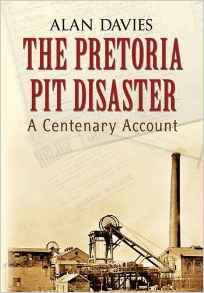
Other Books by Alan Davies [active link]
Local Memorial Service.
The Westhoughton Local History Group have a page and links to the event and there is an annual short memorial service.
A YouTube video of the 2016 memorial service can be viewed at:
http://www.pretoria.org.uk/Pretoria_Pit_Disaster/Home.html
https://youtu.be/DMTgNymU_WE
Memorial. At site above ground of the explosion point.

A short note on Mr Alan Davies.
Mr Davies was born in Atherton, Lancashire. The town had three collieries operating at the time, probably where Alan's interest came from, as well
as through family members working in the industry.
Alan worked in mining at five collieries, Parkside, Coventry, Bickershaw, Castle Drift, Wigan and was recently managing Hilltop Colliery, Bacup.
He studied mining at St Helens College, and art and design at Wigan and Bristol for four years gaining his B.A.(Hons).
He was Curator of the Lancashire Mining Museum, Salford for fifteen years until closure in 2000. He qualified as an archivist with
Liverpool University, and became in charge of Wigan Record Office until 2007. He working in various archives until 2011.
Recently returning to mining as colliery manager, Hilltop Colliery drift, Bacup, Lancashire’s last coal mine.
See the YouTube video on the Hilltop Colliery, Bacup mine.
https://www.youtube.com/watch?v=2yZrVDiAg_E
Since then he has carrying on speaking to local societies and leading guided walks and researching books.
His other personal interests include flying light aircraft, aerial, general and underground photography,
writing mining historical works, riding classic motorcycles.
Thanks
We, the members of Culcheth Local History Group, send him our sincere thanks for a good talk and an enjoyable evening.
- Details
- Category: Reports
Moses Holden, 18th Century Celebrity Astronomer.
20161230 Moses Holden, 18th Century Celebrity Astronomer.
Mr Stephen R Halliwell gave an illustrated talk about a self taught person, Moses Holden, who became a 'celebrity' from his researches and made his own astronomical tools and lenses and theatre props. He gave paid lectures all over the north of England to earn a vast amount for these days, after having started out as a Methodist Lay Preacher.
His earnings once established on the lecture circuit of 18th century England were comparable only with a 'celebrity' footballer or singer in
today's terms. Ultimately he had a modern research telescope named after him, “The Moses Holden Telescope” at the Jeremiah Horrocks Institute, UCLAN, itself named after Moses Holden’s boyhood hero astronomer Jeremiah Horrox.
Refer to "Further Study" at end of this page to obtain photographs and diagrams which can illuminate the popular astronomers who followed in Moses Holden's footsteps.
Surprise ending.
We learned at the end of the talk that this Moses Holden telescope was opened by our speaker. A most notable event for his biographer.
The telescope team has reported investigations and discoveries in fields which are listed on the UCLAN website with details of the folk involved:
The current astronomers:
http://www.star.uclan.ac.uk/solar/people.
A link to the opening of the telescope by Stephen R Halliwell.
University of Central Lancashire [UCLAN] link to opening:
http://www.star.uclan.ac.uk/alston/posters/alston_poster_2.pdf

Report.
Meanwhile to the report of the interesting talk, which by its opening about his early theological activities as a Methodist Lay Preacher
might have indicated a dreary talk, but no! It was a talk of a bold young man determined to learn about his hero Jeremiah Horrocks and
learn among many other subjects astronomy, which meant of course learning mathematics and physics and making his own lenses and apparatus, which he also made and sold to others. The cost for his books when learning were very great relative to his income level,
however he got them to improve himself.
A report from a University of The Third Age at Todmorden on a similar talk by Mr Halliwell gives a better description than the
current writer could do, so it is quoted in full:
QUOTE
Moses Holden talk at Todmorden U3a
Moses Holden, Autodidact of Preston written by Anthony Peter
Steve Halliwell with Gill Radford, Vice Chair of Todmorden U3a
Steve Halliwell, Todmorden U3A’s guest speaker on Thursday 15th September, is a man who clearly knew a lot about a Preston man, Moses Holden, who also knew a lot. Consequently, by the end of Steve’s lecture we had been as well enlightened as those who attended Moses Holden’s packed lectures on the science of ‘ouranology’ in the first half of the nineteenth century would have been.
Steve’s first slide showed we were in for a less dull ride than the phrase ‘methodist evangelist’ might have suggested to many of us:
‘Moses Holden: self-taught genius, the Mozart of the astronomical world, a founder of UCLAN, constructor of telescopes, travelling
lecturer (pre-railway) – From hand-loom weaver to Freeman of Preston’.
And so it proved. Steve’s interest in local history had led him to research Preston’s Learned Societies that grew out of the town’s
early Literary and Philosophical Society, and which, when it established its Mechanics’ Institute in 1828, named it instead its
Institution for the Diffusion of Knowledge at the suggestion of one Moses Holden.
Indeed, The University of Central Lancashire regards itself as the descendant of that Institute.
Moses Holden was undoubtedly a remarkable man. Born in Bolton in 1777, his father, a hand-loom weaver, moved the family to Preston in 1784.
Father Holden liked to read stories to his children, and Moses, after hearing about Jeremiah Horrocks and his recording of the Transit of Venus
in 1639, determined that he would be an astronomer when he grew up.
Moses followed his father into the cloth industry as a weaver and married a woman from Whitehaven with whom he had three children with the
exciting names of William Archimedes, John Horatio and Annie Leonora.
The fact that the boys were born in Pontefract and Banbury tells a story itself. Moses became a travelling preacher and lecturer.
In 1810 he undertook an eighteen month circuit tour of the north-west for the Methodist Church, based in Poulton-le-Fylde. He ran Sunday Schools and Bible Groups and was known for a good sermon. He probably travelled on foot.
However, by 1815 his private studies of mathematics and astronomy enabled him to offer triennial lectures at the Theatre Royal in Preston.
These would be lectures given over a period of three evenings, each lecture packing the building. In time, Moses toured these lectures, and
Steve’s researches of where the lectures were held led him to conclude that Moses was using the canals (much as Mikron Theatre do today).
This presumed use of canals explains the circumstances of the Holden sons’ births.
The lectures were quite something, featuring a magic lantern and an orrery (mechanical model of the solar system), both of Moses’ own making.
Doubtless, he would also have made some profit from sales of his ‘Celestial Handbook and Almanac’, copies of which he sent to both William IV
and William Rogerson, the Astronomer Royal with whom he became very friendly.
Nevertheless, after his death in 1864, Mrs Holden advertised the almanac as available by post at the knock-down price of 2/-.
Perhaps by then they were cluttering up her house!
As a lecturer, Moses could turn a pretty penny. In 1844, in Liverpool he was in such demand that he could packs halls for three sets
of three lectures. And in 1852, his account books show that his set of farewell lectures in Preston netted him about £120 with only
£21 expenses (which included a consideration for ‘oils’ with which to freshen the air of the theatre).
For this writer, ( "Anthony Peter") Moses was most impressively a self-taught man excited by knowledge and its capacity to enrich life. He was also skilled in making and selling telescopes. His achievements have recently been celebrated and commemorated by UCLAN who have named their ‘70 cm diameter state-of-the-art robotic telescope’ the Moses Holden Telescope at a ceremony Steve was delighted to have attended.
UNQUOTE
References:
There is a brief note in Dictionary of National Biography, 1885-1900,Volume 27 on “Holden, Moses; by Charles William Sutton
Link:
https://en.wikisource.org/wiki/Holden,_Moses_(DNB00)
Some of his letters are held in Lancashire Archives:
Link:
http://discovery.nationalarchives.gov.uk/details/c/F335
BOOK.
Mr Halliwell’s biography is available from him at a cost of £11.99 including postage or from booksellers.
http://www.stephenhalliwell.com/p/blog-page_26.html

University of The Third Age [ U3a] links:
http://www.u3a.org.uk/
http://u3atod.org.uk/
UCLAN, University of Central Lancashire links:
http://www.uclan.ac.uk/about_us/facilities/alston_observatory.php
http://www.star.uclan.ac.uk/alston/
The University of Central Lancashire's Jeremiah Horrocks Institute sometimes offers a series of free public observing nights
at their Alston Observatory (http://www.star.uclan.ac.uk/alston/) over the winter months.
Link to photo of telescope:
http://www.uclan.ac.uk/about_us/facilities/assets/images/Alston-Telescope-3-500.jpg
http://www.star.uclan.ac.uk/alston/
University_publicity_posters. The man and the curent work.
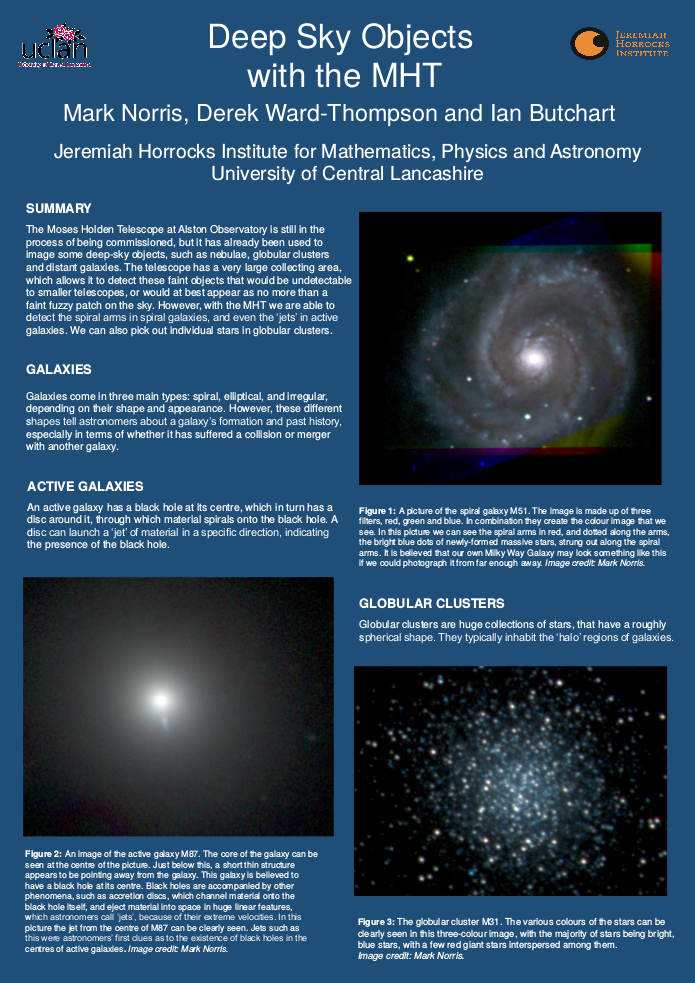
The portrait (copy of one in a relative's possession) and note on Moses Holden published by UCLAN
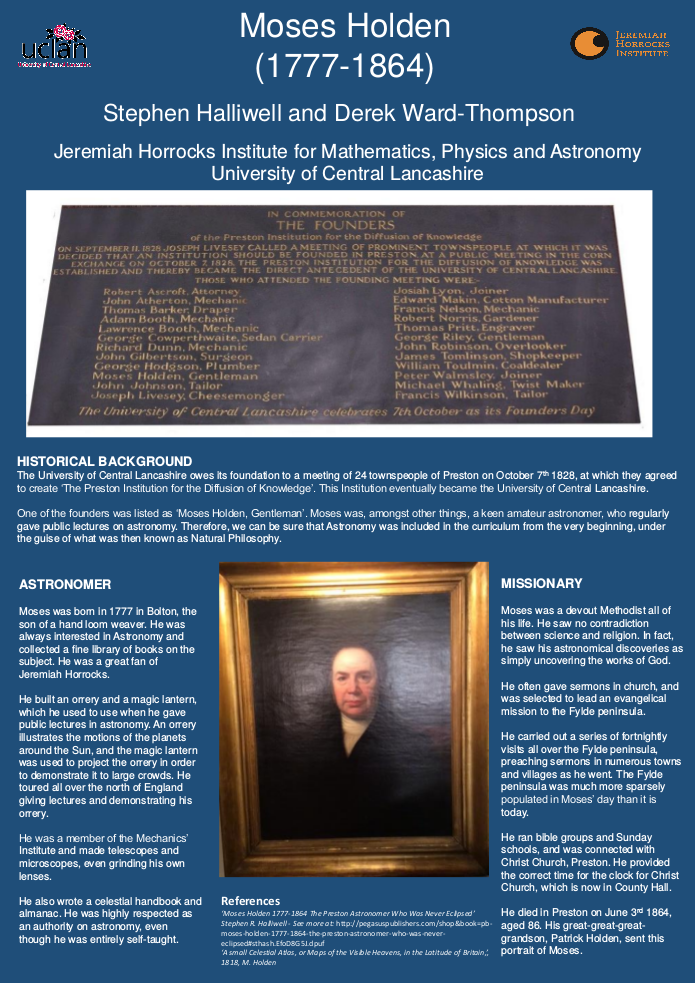
At the conclusion o fthe talk, the audience of CLHG members and visitors gave a warm appreciation to the speaker at our Archivists vote of thanks.
Webmaster's notes. Further Study.
For the members and guests of CLHG who are interested in the 'popularisation' of astronomy, during the 1800s
of whom Moses Holden was an early and learned example, and who are interested in views/diagrams/photos of the
machines involved, there is a reference to a Ph. D. Thesis and articles by Dr Hsiang-Fu Huang.
The diagrams and photographs are at the end in the appendices on pages 385 to 416 and include beautiful photographs
of various orreries and possible interpretation of the big 16 feet (5m) or more accross great orreries.
Dr. Huang's Ph. D. thesis reference.
Title: Commercial and Sublime: Popular Astronomy Lectures in Nineteenth Century Britain
Author: Hsiang-Fu Huang
Academic institute: UCL (University Colledge London); Department of Science and Technology Studies
Thesis submitted for the degree of Doctor of Philosophy (PhD) in History and Philosophy of Science March 2015
Text and illustration of thesis available at
http://discovery.ucl.ac.uk/1462935/1/PhD_Huang.pdf



